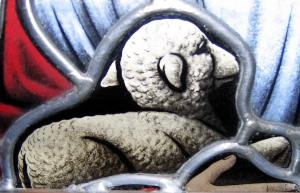Objects are visualized in stained glass because the artist paints them. Faces, robes etc. are seen in stained glass because they are painted on the stained glass. The painted piece of stained glass is fired in a kiln so that the paint becomes a permanent part of the glass. It is almost impossible to remove the fired paint from the glass. In fact, even the paint is made of glass. Since the glass must be fired, the painting must be done on the pieces of glass before they are leaded into the panel.
On complex objects, such as a face, the painting is done in layers. Each layer is fired in a kiln. In this way, the artist can redo a layer to the last firing. It is not uncommon to have a complex object fired 12 to 15 times.
Before objects are painted the artist outlines the pieces. Outlining can more clearly identify the object because glass often can not be cut to the precision of the outline.

See how the artist has painted the outline of the lamb and the black area between the lead came and the sheep's body, the black area between the lamb's nose and his body and the area between the fingers?
In addition to outlining objects, further visual effects are achieved by shading. The artist completely darkens the area to be shaded and then carefully removes the paint for the desired affect. In the photo to the left, note the lamb's wool and folds in the clothing.

